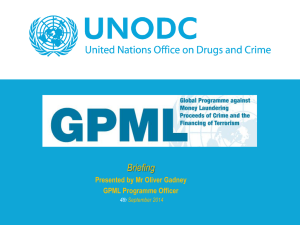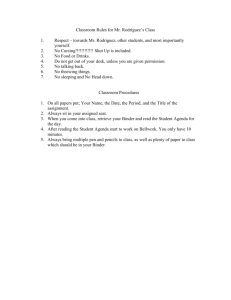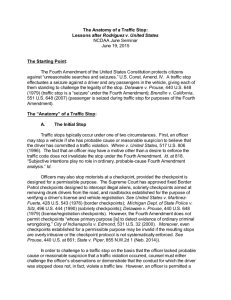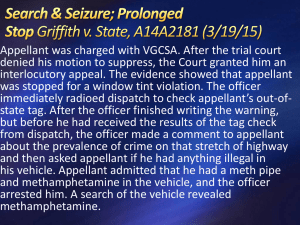Rodriguez v. United States: What Is the 'Mission' of a Traffic Stop?
advertisement
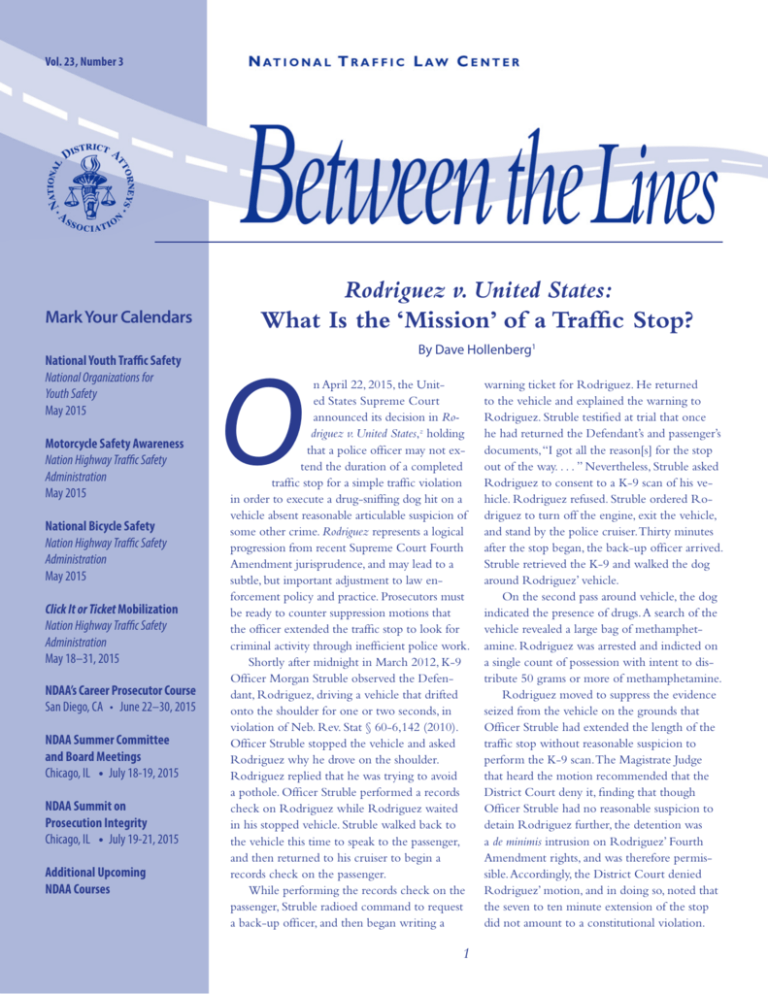
Vol. 23, Number 3 Mark Your Calendars National Youth Traffic Safety National Organizations for Youth Safety May 2015 Motorcycle Safety Awareness Nation Highway Traffic Safety Administration May 2015 National Bicycle Safety Nation Highway Traffic Safety Administration May 2015 Click It or Ticket Mobilization Nation Highway Traffic Safety Administration May 18–31, 2015 NDAA’s Career Prosecutor Course San Diego, CA • June 22–30, 2015 NDAA Summer Committee and Board Meetings Chicago, IL • July 18-19, 2015 NDAA Summit on Prosecution Integrity Chicago, IL • July 19-21, 2015 Additional Upcoming NDAA Courses Rodriguez v. United States: What Is the ‘Mission’ of a Traffic Stop? O By Dave Hollenberg1 n April 22, 2015, the United States Supreme Court announced its decision in Rodriguez v. United States,z holding that a police officer may not extend the duration of a completed traffic stop for a simple traffic violation in order to execute a drug-sniffing dog hit on a vehicle absent reasonable articulable suspicion of some other crime. Rodriguez represents a logical progression from recent Supreme Court Fourth Amendment jurisprudence, and may lead to a subtle, but important adjustment to law enforcement policy and practice. Prosecutors must be ready to counter suppression motions that the officer extended the traffic stop to look for criminal activity through inefficient police work. Shortly after midnight in March 2012, K-9 Officer Morgan Struble observed the Defendant, Rodriguez, driving a vehicle that drifted onto the shoulder for one or two seconds, in violation of Neb. Rev. Stat § 60-6,142 (2010). Officer Struble stopped the vehicle and asked Rodriguez why he drove on the shoulder. Rodriguez replied that he was trying to avoid a pothole. Officer Struble performed a records check on Rodriguez while Rodriguez waited in his stopped vehicle. Struble walked back to the vehicle this time to speak to the passenger, and then returned to his cruiser to begin a records check on the passenger. While performing the records check on the passenger, Struble radioed command to request a back-up officer, and then began writing a 1 warning ticket for Rodriguez. He returned to the vehicle and explained the warning to Rodriguez. Struble testified at trial that once he had returned the Defendant’s and passenger’s documents, “I got all the reason[s] for the stop out of the way. . . . ” Nevertheless, Struble asked Rodriguez to consent to a K-9 scan of his vehicle. Rodriguez refused. Struble ordered Rodriguez to turn off the engine, exit the vehicle, and stand by the police cruiser. Thirty minutes after the stop began, the back-up officer arrived. Struble retrieved the K-9 and walked the dog around Rodriguez’ vehicle. On the second pass around vehicle, the dog indicated the presence of drugs. A search of the vehicle revealed a large bag of methamphetamine. Rodriguez was arrested and indicted on a single count of possession with intent to distribute 50 grams or more of methamphetamine. Rodriguez moved to suppress the evidence seized from the vehicle on the grounds that Officer Struble had extended the length of the traffic stop without reasonable suspicion to perform the K-9 scan. The Magistrate Judge that heard the motion recommended that the District Court deny it, finding that though Officer Struble had no reasonable suspicion to detain Rodriguez further, the detention was a de minimis intrusion on Rodriguez’ Fourth Amendment rights, and was therefore permissible. Accordingly, the District Court denied Rodriguez’ motion, and in doing so, noted that the seven to ten minute extension of the stop did not amount to a constitutional violation. Rodriguez pled guilty but appealed the ruling on his motion. The Eighth Circuit affirmed. The Supreme Court granted certiorari, seeking to resolve a long-standing circuit split on the issue of whether police may extend an otherwise completed traffic stop absent reasonable suspicion of a crime.3 Writing for the majority, Justice Ginsburg acknowledged lllinois v. Caballes, where the Court held that a traffic stop can include an investigatory dog sniff separate from the initial rationale for the stop.4 However, Ginsburg wrote that in Caballes the Court indicated that a roadside detention “can become unlawful if it is prolonged beyond the time reasonably required to complete th[e] mission . . . .”5 The mission in this case was to issue a traffic warning for driving on the shoulder. Rodriguez was detained for an additional seven to ten minutes following the completion of the traffic stop. The majority found that this extended detention violated Rodriguez’ Fourth Amendment protection from unreasonable seizures.6 The majority also squares its rationale with its prior Fourth Amendment jurisprudence, most notably Pennsylvania v. Mimms7 and Maryland v.Wilson.8 While the Eighth Circuit relied heavily on the holding in Mimms, which balanced a police officer’s need for safety with the defendant’s right to remain in a vehicle, the majority highlighted the difference between “ordinary inquiries incident to the traffic stop”9 and conducting a dog sniff, which is a device designed to investigate potential criminal activity.10 In doing so, the majority acknowledges that this case highlights the distinction between a stop for a simple traffic violation, and a Terry stop where there is reasonable suspicion of criminal activity.11 Ginsburg emphasizes that the basic mission of a traffic stop should be to ensure traffic and officer safety; further inquiry on the part of the officer requires reasonable suspicion. Because the Eighth Circuit did not decide whether or not Officer Struble had formulated reasonable suspicion sufficient to continue detaining Rodriguez, the majority did not make a finding as to this issue, and remanded the case for further consideration. In dissent, Justice Thomas (joined by Justice Alito, and in part by Justice Kennedy) fervently disputes the majority’s reasoning on a number of fronts, most notably its perceived divergence from Fourth Amendment precedent.12 Thomas stresses that the majority has decided to stray too far from the Caballes holding, which indicates the stop was “lawful at its inception and otherwise executed in a reasonable manner.”13 For Thomas, performing a dog sniff is functionally similar to asking questions of a defendant as part of routine police investigation.14 Additionally, Thomas is concerned that the logic of the decision contradicts the court’s holding in Whren v. United States,15 and would disadvantage officers based on their physical and mental characteristics. Justice Alito’s sole dissent raises many of the same issues, but he and Thomas agree that Officer Strubel had reasonable suspicion to detain Rodriguez, based on an “overwhelming odor of air freshener” and the fact that to Officer Strubel, Rodriguez’s passenger appeared to be nervous.16 Both the majority and the dissent allude to, but fail to directly address, the Court’s holding in United States v. Place.17 This decision may signal a shift away from that strain of Fourth Amendment jurisprudence. Place, at the time of its decision, represented a significant extension of the classic “reasonable expectation of privacy” test. The Court held that a dog sniff is not a “search” under the Fourth Amendment. It does not share the same qualities as, for example, rummaging through someone’s bag at an airport.18 The Rodriguez majority labels a dog sniff “a measure aimed at detecting evidence,”19 which in the absence of the word, appears to come about as close as possible to calling the practice a “search” without uttering it. For prosecutors, the importance of this case largely depends on state case law. Some states already prohibit extension of a traffic stop to conduct the type of investigation at issue in Rodriguez.20 In other jurisdictions, courts have determined that de minimis extensions of traffic stops are constitutional and treat those stops differently from a traditional interaction between police and the public. This decision addresses those distinctions and brings federal and state law into alignment on an important issue for law enforcement. It remains to be seen how the Eighth Circuit will handle the issue of reasonable suspicion on remand — it may very well hold that Officer Struble did have reasonable suspicion to order the dog sniff, based on the facts discussed in both dissents. The Court’s decision in Rodriguez will likely require police departments to highlight the importance of efficiency in traffic stops. Defense attorneys could raise two objections: first, that the officer initiated criminal investigation after issuance of a traffic ticket; and second, that the officer deliberately lengthened the stop beyond its necessary purpose. As a result, officers should understand the importance of completing the basic tasks of a traffic stop rapidly. Their supervisors should continue to train them in the art of questioning suspects, while emphasizing efficiency. Further, officers should fully articulate and document their suspicion so that prosecutors can argue how the officers’ suspicions are reasonable. In this case, the officer’s suspicion was correct. However, it is now clear that there is no longer a de minimis allowable extension of a traffic stop. Therefore, the officer must fully articulate his or her suspicion and the government must argue the reasonableness of the suspicion, not just as an alternative. Rodriguez is a further reminder that prosecutors and law enforcement must work together to ensure that future traffic stops are conducted under these clarified requirements. Endnotes 1Staff Attorney, National Traffic Law Center, National District Attorneys Association. 2 No. 13-9972, 2015 WL 1780927 (U.S. 2015). 3Compare, e.g., United States v. Morgan, 270 F.3d 625 (8th Cir. 2001) (allowing a delay of ten minutes after a traffic stop), with State v. Baker, 229 P. 3d 650, 658 (2010) (prohibiting any extension). 4 543 U.S. 405, 407 (2012). 5 Id. 6 Rodriguez, No. 13-9972, 2015 WL 1780927, at *6. 2 7 434 U. S. 106 (1977) (per curiam). 18 See Id. at 707. 8 5 19 U. S. 408, 413 (1997) (holding that police may require passengers to exit a vehicle that has been stopped for a traffic violation). 19 Rodriguez, No. 13-9972, 2015 WL 1780927 at *6 (citing Indianapolis v. Edmond, 531 U. S. 32, 40–41 (2000)). 9 R odriguez, No. 13-9972, 2015 WL 1780927, at *6 (citing Delaware v. Prouse, 440 U. S. 648, 658–660 (1979)) (suggesting that typical inquiries may include license checks, warrant checks, and insurance/registration checks). 20 See, e.g., Pryor v. State, 122 Md. App. 671 (Md. Ct. Spec. App. 1998); State v. Wiegand, 645 N.W.2d 125 (Minn. 2002). 10 See Indianapolis v. Edmond, 531 U. S. 32, 40–41 (2000). 11 S ee Navarette v. California, 134 S. Ct. 1683 (2014) (holding that an anonymous tip can be enough to allow a police officer to form reasonable suspicion that a crime [driving while intoxicated] was being committed). Congratulations to Ken Stecker on the NHTSA Public Service Award 12 See, e.g, Brigham City v. Stuart, 547 U. S. 398 (2006) (holding that reasonableness is the most important Fourth Amendment consideration); Ohio v. Robinette, 519 U. S. 33 (1996) (holding that courts must examine Fourth Amendment cases through a totality of the circumstances analysis); and Virginia v. Moore, 553 U.S. 164 (2008) (explaining the individual privacy and legitimate governmental interest balancing test). The National Traffic Law Center congratulates Ken Stecker, Traffic Safety Resource Prosecutor, Prosecuting Attorney’s Association of Michigan, on being a recipient of the NHTSA Public Service Award. The NHTSA Public Service Awards recognize and honor an individual or organization who: 1) exemplifies high standards of achievements in the field of traffic safety, and 2) through his/her or the group’s accomplishments, has contributed to the quality of life in the community, state or nation. Ken was recognized for his outstanding service in protecting communities and enhancing traffic safety by providing expert legal advice and training resources to Michigan’s criminal justice community. 13 Rodriguez, No. 13-9972, 2015 WL 1780927, at *3 (internal citation omitted). 14 S ee Hiibel v. Sixth Judicial Dist. Court of Nev., Humboldt Cty., 542 U. S. 177 (2004). 15 517 U. S. 806 (1996) (explaining officers’ actions must be viewed objectively, regardless of their state of mind). 16 S ee Rodriguez, No. 13-9972, 2015 WL 1780927 (Thomas, J., dissenting), at *1011; (Alito, J., dissenting) at *1-2. 17 462 U.S. 696 (1983) (holding that a dog sniff is not a search under the Fourth Amendment). ­Between the Lines is published by the National District Attorneys Association’s National Traffic Law Center. Items may be reprinted if properly attributed. Please provide copies of any reprints to the National Traffic Law Center. For questions or other inquiries, contact the National Traffic Law Center at 703.549.9222 or trafficemail@ndaa.org. National Traffic Law Center National District Attorneys Association 99 Canal Center Plaza Suite 330 Alexandria,VA 22314 703.549.9222 Fax: 703.836.3195 www.ndaa.org Joanne Thomka Program Director 703.519.1645 jthomka@ndaa.org Duane M. Kokesch Senior Attorney 703.519.1641 dkokesch@ndaa.org Kristen K. Shea Senior Attorney 703.519.1644 kshea@ndaa.org Dave Hollenberg Staff Attorney 703.519.1653 dhollenberg@ndaa.org Megan Bernardino Project Coordinator 703.519.1695 mbernardino@ndaa.org The National Traffic Law Center is a program of the National District Attorneys Association. This document was prepared under Cooperative Agreement Number DTNH22-13-H-00434 from the U. S. Department of Transportation National Highway Traffic Safety Administration and Grant Number FM-CDL-0140-13-01-00 from the U.S. Department of Transportation Federal Motor Carrier Safety Administration. Points of view or opinions in this document are those of the authors and do not necessarily represent the official positions or policies of the Department of Transportation or the National District Attorneys Association. 3
